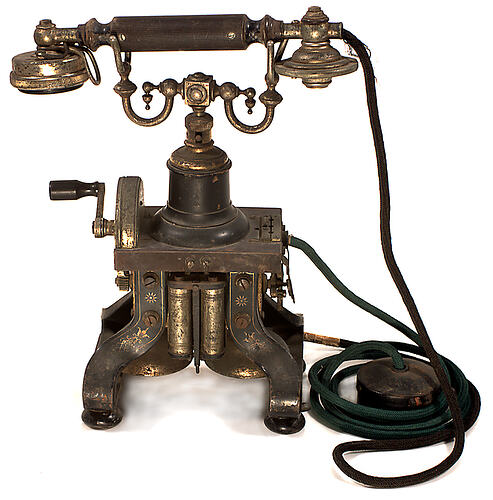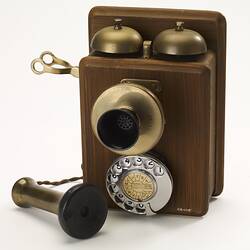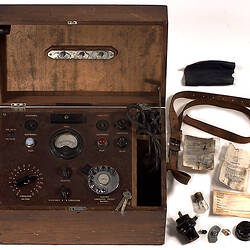Summary
Skeletal Telephone made by L. M. Ericsson, circa 1892. It was used in the Head Office of the Victorian Government Department of Mental Hygiene, circa 1900.
Ericsson Skeletal phones were manufactured from about 1892 until the late 1910s. The ram's horns or metal bars that form the legs are in actual fact the magnets that when the the handle is turned in the generator body creates ac voltage to signal the manual operator or in a point to point service the other phone at the other end.
Physical Description
Telephone has speaking piece with fretted tubular wooden handle (painted black) joining elegantly shaped ear and mouth pieces. Sits on ornate stand shaped like 2 ram's horns extending from cube on end of shaft which fits into top of bell- shaped column, sitting on brown oblong bakelite slab. On left side of this is attached vertical wheel (with semi-circular housing on side facing inward) with winding handle. Connects with one small cog directly below. 4 small screw on front of slab attach wires from cord of mouthpiece. Cord to mains comes out of left side of slab and has circular black metal box on end.4 legs are formed out of 2 thick metal bars (1 each side), twisted to give bowed effect from front or back and at side, etc. Australia's first standard desk set, PMG type 2, 1892.
Significance
In 2006, Mr Stefan Nowak, of Telstra, who was a collector and researcher of early telephones, wrote about this object:
'This is an Ericsson 'skeletal'; the ram's horns or metal bars that form the legs are in actual fact the magnets that when the the handle is turned in the generator body creates ac voltage to signal the manual operator or in a point to point service the other phone at the other end. There should be on the deck which is made of ebonite a serial number by which I can accurately date the phone, 1892 is the common year by which these certain types of phones were manufactured from, they were made from memory up until the late 1910's early 20's. It is basically an early magneto telephone desk set. I have more info at Hawthorn in early Ericsson catalogue detail if you wish this.
From the photo the hand grip of the handset is ebonite not wooden also it appears not to be the origianl for this phone as there is a hanging hook from a wall phone that is inverted and bent downwards. The deck is the flat that has the legs mounted with the generator at the bottom and above the turned beech bobbin that supports the cradle. When dismantling the bobbin from the deck, which can only be done by removing the legs and generator body, you will find inside the bobbin an induction coil. It also appears to be missing paddles which mount under the feet also turned beech with a vinyl insert that keep the legs apart (handy in this application I guess) and provide extra stability for the phone. You will also note that the trumpet is missing from the transmitter and that commonly the peg is missing from the lightning protector on the deck on the opposite side of the generator. The rossette at the end of the line cord is different to the Aussie norm and appears to be a metal version and not ebonite. Cords are usually platted not smooth but this may have been replacement stock or even an early cord.
It is an example of administrative equipment used in psychiatric hospitals in Victoria Australia
More Information
-
Collection Names
-
Collecting Areas
-
Acquisition Information
Donation from Office of Psychiatric Services, May 1985
-
Manufacturer
-
Place Used
Victorian Government Department of Mental Hygiene, Melbourne, Greater Melbourne, Victoria, Australia, circa 1900
-
Inscriptions
RS/TELEFONA.T .ET is printed on worn paper label around mouthpiece cord.
-
Classification
Medicine & health, Mental health - administration, Equipment
-
Category
-
Discipline
-
Type of item
-
overall dimensions
21.5 cm (Length), 14 cm (Width), 33 cm (Height)
-
References
card with exhibit.
-
Keywords
Communication Equipment, Hospitals, Psychiatric Services, Making History - Psych Services


